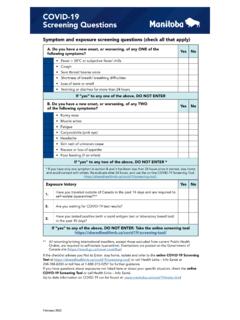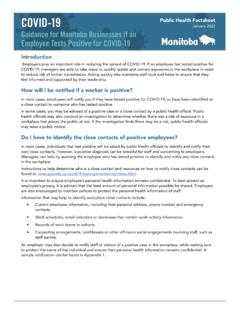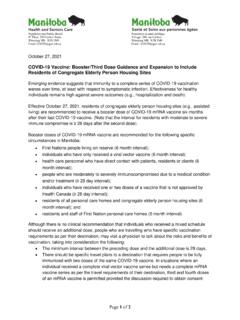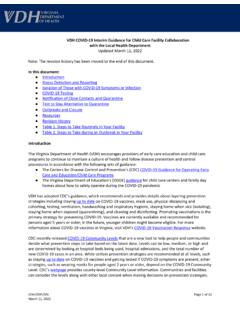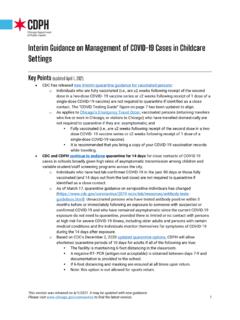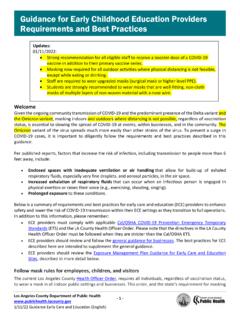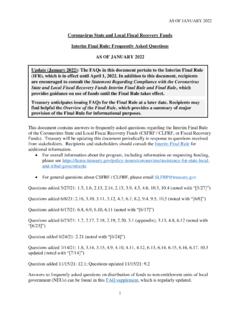Transcription of Interim Guidance Public Health Measures Managing Novel ...
1 Interim Guidance Public Health Measures Managing Novel Coronavirus (COVID-19). Cases and Contacts in Community 2. Table of Contents Summary of 3. Situation .. 4. Background .. 4. Surveillance Case Definitions .. 4. Laboratory Testing .. 6. Contact 9. Public Health Management of Cases .. 9. Public Health Management of Contacts .. 20. Table 1. Categories of contacts by exposure risk level .. 26. Reporting Cases and Contacts .. 37. APPENDIX A: Instructions for Isolating a case in the home or co-living setting .. 41. Isolating in the home setting .. 41. Respiratory etiquette .. 42. Hand hygiene .. 42. Self-care while convalescing .. 45. Precautions for household members ( caregivers, roommates) to reduce risk of transmission to others in the home.
2 46. Core personal Public Health practices .. 49. APPENDIX B: Definitions and Management of COVID-19 Outbreaks and Clusters .. 50. Outbreak Management in Personal Care Homes .. 51. Other Vulnerable Settings .. 52. Workplace Clusters and Outbreaks .. 52. APPENDIX C: Process for investigating COVID-19 cases in school/ child care 55. Declaring School Outbreaks Over .. 58. COVID-19 Assessment Tool for Exposures in School and Child Care Settings .. 59. APPENDIX D-1: Role of the Chief Occupational Medical Officer (COMO) .. 61. APPENDIX D-2: Sample Workplace Exclusion Letter .. 67. APPENDIX E: Other Notification Processes .. 68. APPENDIX F: Direct COVID-19 Tests in Manitoba User's Guide to Characteristics and Interpretation 69.
3 APPENDIX G: COVID Alert App Quick Reference for One Time Key Providers .. 74. APPENDIX H: Supports for Community 80. APPENDIX I: Recommendations for COVID-19 Variants of Concern .. 86. Recommendations for Case and Contact Management Post-Omicron VOC .. 89. APPENDIX J: Flight Manifest Request Process .. 95. 2022-01-11. 3. Summary of Changes January 10, 2022. Extensive updates throughout reflecting changes to case and contact management ( shortening of isolation period based on symptoms and vaccination status), including: o Discontinuation of isolation (pg. 13). o Isolation Guidance for HCWs (pg. 14). o Management of cases (re-infection and rapid antigen test use (pg. 17 18)). o Management of contacts (pg.)
4 22 24; 34). o Reporting of cases & contacts (pg. 39 40). Update to Appendix A Isolating a case in the home or co-living setting (pg. 41). Update to Appendix B Management of COVID-19 Outbreaks and Clusters (pg. 50). Updates to Appendix I Recommendation for Case and Contact Management post- Omicron VOC (pg. 89 - 93). December 20, 2021. Extensive changes throughout the document for the Omicron VOC. o Cases to notify contacts o Discontinuation of active monitoring and contact notification o Alignment of definition of fully vaccinated for contact tracing with vaccine eligibility o Recommendation to test asymptomatic fully vaccinated contacts between 5-7 days o Monoclonal antibody treatment (pg.
5 15). o Updates to Appendix I Variants of Concern (pg. 88 96). November 30, 2021. Updates to Appendix B. o Revised outbreak and cluster definitions and inclusion of examples vulnerable settings (pg. 52 53). November 22, 2021. Discontinuation of routine Public notification of exposures on Public transportation (pg. 36, 98). Removal of process for follow-up of positive rapid antigen tests in absence of PCR testing for Designated Persons. Case management and contact tracing will only occur for PCR positive results (pg. 73). Updates on VOC screening and reporting (pg. 89). Removal of appendix K on enforcement. Follow regional operational processes. 2022-01-11. 4. Situation The strategy outlined in this Guidance is intended to focus on case and contact management to mitigate the Health impacts of COVID-19 on Manitobans.
6 This Guidance is set in the Canadian context and is based on the available scientific evidence and expert opinion. In interpreting and applying this Guidance , it is important to recognize that the Health , disability, economic, social, or other circumstances faced by some individuals and households may limit their ability to follow the recommended Measures . This may necessitate adapted case management and contact responses in some situations. This document is based on the Interim Guidance : Public Health Management of cases and contacts associated with Novel coronavirus from the Public Health Agency of Canada1. Information on the situation is evolving. This Guidance will be updated as further information becomes available.
7 Background First identified in the 1960s, there are now seven known coronaviruses that can infect people. While four of these cause mild-to-moderate illness in humans, recently discovered viruses such as SARS (severe acute respiratory syndrome) and MERS-CoV (Middle East Respiratory Syndrome Coronavirus) can cause severe illness. On January 12, 2020, the World Health Organization confirmed China's detection of a Novel coronavirus (COVID-19) with significant Health impacts. Early information suggest that common symptoms include fever (> 90%), malaise, dry cough (80%), shortness of breath (20%) and respiratory distress (15%).2. Current case numbers can be found on the Johns Hopkins coronavirus website ( #/bda7594740fd40299423467b48e9ecf6).
8 Surveillance Case Definitions Surveillance case definitions are provided for the purpose of standardized case classification and reporting. They are based on the current level of epidemiological evidence and uncertainty, and Public Health response goals, and are subject to change as new information becomes available. These surveillance case definitions are not intended to replace clinician or Public Health practitioner judgment in individual patient management or testing, or for the purpose of infection 1. PHAC. Interim Guidance : Public Health Management of cases and contacts associated with Novel coronavirus (COVID-19) (February 6, 2020). 2. Hui, D. S., Azhar, E., Madania, T.
9 A. et al 2020. Continuing COVID-19 epidemic threat of Novel coronavirus to global Health the latest 2019 Novel coronavirus outbreak in Wuhan, China. International Journal of Infectious Diseases, 91; 264-266 ( (20)30011-4/fulltext). 2022-01-11. 5. control triage. For current screening and testing advice, please refer to Suspect case . A person with symptoms compatible with COVID-19. AND. Had close contact with a probable case of COVID-19. Note: COVID-19 may present as a co-infection with other pathogens. At this time, the identification of one causative agent should not exclude COVID-19 where the index of suspicion may be high. Probable case . A person who: 1. Has symptoms compatible with COVID-19.
10 AND. Had a high-risk exposure with a confirmed COVID-19 case ( close contact) OR was exposed to a known cluster or outbreak of COVID-19**. AND. Has not had a laboratory-based NAAT assay for SARS-CoV-2 completed or the result is inconclusive*. OR. Had SARS-CoV-2 antibodies detected in a single serum, plasma, or whole blood sample using a validated laboratory-based serological assay for SARS-CoV-2 collected within 4. weeks of symptom onset (note serological assays are not routinely done for diagnostic purposes)*. OR. 2. Had a POC NAAT or POC antigen test for SARS-CoV-2 completed and the result is preliminary (presumptive) positive*. OR. 3. Had a validated POC antigen test for SARS-CoV-2 completed and the result is positive*.


